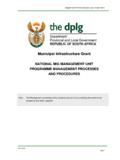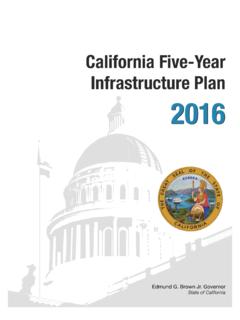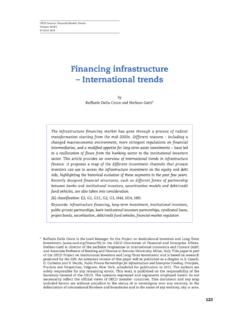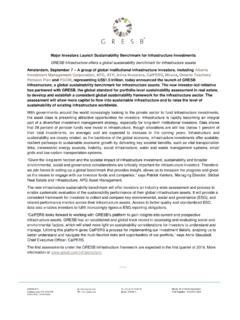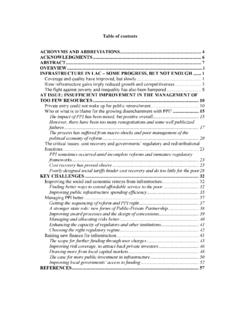Transcription of NYC GREEN INFRASTRUCTURE
1 NYC GREEN INFRASTRUCTURE . 2016 ANNUAL REPORT. Bill de Blasio Mayor Vincent Sapienza Acting Commissioner 0. Table of Contents Introduction .. 1. Building Organizational Capacity ..3. Staffing Program Staff and Partner Agency Support ROW GREEN INFRASTRUCTURE Maintenance Capital Funding Expense Funding Project Tracking and Data Management Communication Strategies and Educational Activities Regulatory and Rulemaking Activities Citywide Implementation ..9. Right-of-way GREEN INFRASTRUCTURE Standard Designs Public Property Retrofits NYC Department of Parks and Recreation (DPR). NYC Department of Education (DOE). NYC Department of Education with the Trust for Public Land (TPL) GREEN INFRASTRUCTURE Playgrounds NYC Housing Authority (NYCHA). NYC Department of Design and Construction (DDC) Public Buildings Unit Integrated Watershed Planning GREEN INFRASTRUCTURE Incentives for Private Property Owners GREEN INFRASTRUCTURE Grant Program Expanded Private Incentive Program Planning New Private Incentives Framework 2012 Stormwater Performance Standard GREEN INFRASTRUCTURE Program Status Adaptive Management and Lessons Learned.
2 19. Program Implementation Challenges and Lessons Learned In the ROW. On Public Properties GREEN INFRASTRUCTURE Research and Development Program Performance Metrics Report GREEN INFRASTRUCTURE Monitoring Permeable Pavement Pilot Project Local Law 80 of 2013. Exhibits ..24. Exhibit A 2016 Meetings and Presentations Exhibit B Public Property Retrofits with the Department of Parks and Recreation Exhibit C Public Property Retrofits with the Department of Parks and Recreation: Community Parks Initiative Phases 1-3. Exhibit D Public Property Retrofits with the Department of Education Exhibit E Public Property Retrofits with the Department of Education and the Trust for Public Land: Schoolyards to Playgrounds Exhibit F Public Property Retrofits with the NYC Housing Authority Exhibit G Public Property Retrofits with the Department of Design and Construction Public Buildings Exhibit H Public and Private Property Retrofits in the GREEN INFRASTRUCTURE Grant Program Introduction This 2016 Annual Report provides updates on the New york city Department of Environmental Protection's (DEP) GREEN INFRASTRUCTURE Program (the Program ).
3 Officially launched in 2011 after years of foundational work, the Program is a multiagency partnership effort led by DEP. The Program goal is to reduce combined sewer overflows (CSO) into the waterways of New york city by managing stormwater from impervious surfaces using GREEN INFRASTRUCTURE (GI) technologies. The Program is progressing toward its 2030 CSO reduction goal by retrofitting the city 's streets, sidewalks and other public property, and incentivizing retrofits on private property. The Program is also responsible for performing maintenance of constructed GI in the right-of-way (ROW), conducting research and development, engaging elected officials and civic stakeholders, tracking all GREEN INFRASTRUCTURE projects, and GI mapping and data management efforts. To date, the Program has prioritized implementation in combined sewer tributary areas based on CSO volume, frequency of overflow, and consideration of anticipated benefits of projects constructed through DEP's Waterbody/Watershed Facility Plans or other planning efforts.
4 DEP also notes outfalls in close proximity to existing and planned public access locations. Over the last five years, DEP has successfully installed thousands of ROW rain gardens and other GREEN INFRASTRUCTURE practices in Priority CSO Tributary Areas under so-called Area-wide GI contracts. Thousands more GI practices are in planning, design, and construction phases. To identify future opportunities, DEP will gradually shift the focus of the Program from primarily ROW to public on-site and private GREEN INFRASTRUCTURE implementation though strategic planning, growing our interagency partnerships, and developing innovative incentive programs. DEP has committed to staff increases described in the Organizational Capacity section in addition to increasing consultant and professional services to support a focused effort to bring these initiatives to scale. In 2016, the Program advanced all programmatic areas of citywide implementation. Most notably: Continued to advance nearly 200 public property retrofits with city agency partners Initiated new Area-wide ROW GI contracts in the Bronx, Brooklyn and Queens Initiated a strategic planning effort to evaluate GREEN INFRASTRUCTURE opportunities at the watershed scale, including both combined and separate sewer areas Submitted the following two reports to the New york State Department of Environmental Conservation (DEC): o The Contingency Plan submitted on June 27, 2016, outlined the Program plan for reaching the implementation milestone.
5 The Contingency Plan showed the planned projects that will reach the remaining impervious acres needed by 2020. o The Performance Metrics Report submitted on June 30, 2016 describes CSO reductions based on the GREEN INFRASTRUCTURE implementation rate and a modeled CSO volume reduction based on the 10% implementation rate. The report also included an equivalency rate based on the implementation rate that reflects the initial phase of the Program, which relied primarily on retention-based ROW GREEN INFRASTRUCTURE . 1. This 2016 Annual Report provides updates on all Program activities, as well as on the impervious acres managed through 2016, estimated impervious acres projected to be managed through 2017, and Program funding. Previous Annual Reports and the GREEN INFRASTRUCTURE Plan can be found on DEP's website here. Students, faculty, and staff gather for a DOE/TPL GREEN INFRASTRUCTURE Playground opening 2. Building Organizational Capacity Staffing Program Staff and Partner Agency Support In 2016, the DEP Office of GREEN INFRASTRUCTURE was reorganized and the staff was distributed between the Bureau of Environmental Planning and Analysis (BEPA) and the Bureau of Engineering Design and Construction (BEDC).
6 This reorganization allows the growing responsibility areas of the program to be more efficiently carried out by staff experienced in those areas, particularly leveraging existing design and construction expertise within BEDC. Under this new organization, BEDC staff will continue to advance ROW implementation through design, project management, and construction oversight. BEPA staff will continue to sustain agency partnerships, facilitate all planning efforts, provide program and budget oversight, and manage implementation of public property retrofit and private property incentive programs. In 2016, new staff was hired to support the expanding design and construction work, to provide additional support for construction oversight and inspection, and to assist in asset mapping and tracking. DEP also continues to fund full-time staff at our partnering agencies, the New york city Department of Transportation (DOT) and the New york city Department of Parks and Recreation (DPR) who provide design review for primarily the ROW projects.
7 The total count of Program staff positions across the three city agencies is now 55. Additionally, DEP could not have advanced the Program as quickly as it has without the organizational capacity of our agency partners including the New york city Economic Development Corporation (EDC) and the New york city Department of Design and Construction (DDC) who manage many ROW design and construction contracts. EDC also manages a large portfolio of design and construction for many of the current public property retrofit projects and assists DEP in the interagency coordination with the New york city Housing Authority (NYCHA), the New york city Department of Education (DOE), and DPR. These partnerships are critical to the ongoing success of the Program. Table 1: DEP and Partner Agency GREEN INFRASTRUCTURE Program Staffing by Year Total Headcount per Calendar Year GREEN INFRASTRUCTURE Program 2014 2015 2016. DEP (BEPA, BEDC) 21 25 49. DPR 3 5 5. DOT 1 1 3. TOTAL 25 31 55.
8 2017 ACTION ITEM: DEP will continue to add new staff to expand the public property retrofit and private property incentive programs as well as for NYC GreenHUB, mapping, and data management team. 3. Additionally, DEP will fund new staff at DPR and DOE to support those agencies to review and facilitate the growth in projects on their properties, respectively. ROW GREEN INFRASTRUCTURE Maintenance During 2016, DEP's Bureau of Water and Sewer Operations (BWSO) continued to provide maintenance for completed ROW GREEN INFRASTRUCTURE practices in Brooklyn, Queens and the Bronx. BWSO GREEN INFRASTRUCTURE Maintenance staff also provided supplemental maintenance to ROW GI practices that were still under the contract guarantee period. Table 2: DEP ROW GREEN INFRASTRUCTURE Maintenance Staffing by Year Total Headcount per Calendar Year GREEN INFRASTRUCTURE 2014 2015 2016. Maintenance DEP (BWSO) 15 23 25. Note: Total Headcount includes both full-time and part-time, seasonal titles.
9 The maintenance of GREEN INFRASTRUCTURE practices within publicly owned property such as DOE's schoolyards is typically carried out by the owner agency. DEP has agreed to maintain the GREEN INFRASTRUCTURE retrofits located on NYCHA property and has provided maintenance for those constructed projects throughout 2016. 2017 ACTION ITEMS: BWSO GREEN INFRASTRUCTURE Maintenance will hire 40 more staff in 2017 to provide maintenance for newly constructed ROW GI practices. BWSO will establish an additional maintenance facility in the Bronx to eliminate excess travel time and to improve the overall efficiency of the Bronx GI maintenance crew. In addition, BWSO has completed a facility plan for its central maintenance facility located in Greenpoint, Brooklyn. BWSO will also begin providing supplemental maintenance for those assets still under contractor guarantee, where necessary. DEP will continue to provide maintenance for NYCHA projects throughout the useful life of the assets.
10 4. Capital Funding Capital funding covers costs such as site selection, design, construction, and construction management for GREEN INFRASTRUCTURE projects. As of March 2017, the Program had encumbered over $410 million with another $1 billion budgeted over the next 10 years. This capital funding will support GREEN INFRASTRUCTURE contracts undertaken by DEP and agency partners, including the Area-wide contracts, retrofit projects with other city agencies, Trust for Public Land partnership projects, and the Grant Program. Encumbered capital funding are funds that are registered into capitally funded contracts such as professional services and construction contracts. These funds are committed to those projects (or contracts) and are spent down over the course of the contract term. The Capital Budget is a budgeting document that outlines the Program's projected capital commitments over a period of time, a four-year plan or a 10-year plan. Table 5: Capital Funding Encumbered and Budgeted Encumbered Capital Fiscal Year Funding FY12 $9,015,345.












